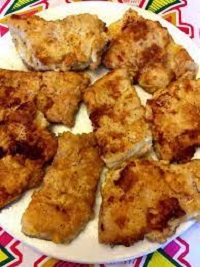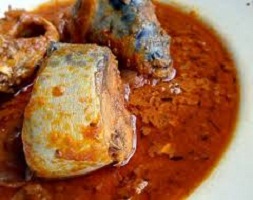How to Fry Fish Coated with Flour: Pan Fried Fish
How to Fry Fish Coated with Flour: Pan-Fried Fish

A simple yet delightful recipe is fish sprinkled with flour and fried till crispy. The flour browns well and leaves just a slight bit of a crust on the fish.
Fried fish has been one of the quickest and simplest street foods; if you’re familiar with any fish stand in Nigeria.
You’ll remember how some fried fish are usually spread out on news peppers with fried plantain chips or potato chips by some roadside sellers, especially during the evening hours.
Fried fish may be eaten with almost any type of meal; you can even dip it in tomato stew or ketchup and eat it for lunch or dinner, or offer it as a side dish with a salad or jollof rice.
How to Fry Fish Coated with Flour
Don’t be fooled by the simplicity of this excellent fried fish recipe: This 30-minute dish is ideal for a busy weekday or to serve as a weekend lunch with a salad and a few dipping sauces.
The secret to flawless fried fish is in the cooking oil and temperature, as well as the coating used on the fish.
How to Fry Fish Coated with Flour: Types of Nigerian Oil Good for Fish Frying
- Power oil
- Mamador
- Devon kings oil
- Grand soya oil
- Nosak famili vegetable oil
- Activa vegetable oil
- Presco
- Vino vegetable oil
Avoid using olive oil or butter since they will burn at the high temperatures needed for frying.
Benefits of frying fish with flour: How to Fry Fish Coated with Flour
It’s simple to cook tender white fish till it breaks apart in the pan. Unlike other animals’ flesh, fish has little to no fat between the tissues and no membranes to hold them together.
Don’t omit flour coating the fish since it adds a great crunchy texture, keeps the fish from absorbing too much oil, and keeps the fish intact.
Use a heavy-bottomed pan for the greatest results because it spreads and cooks evenly.
The flour coating seals the skin of the fish, keeping the soft insides together. Cooking times for pan-fried fish are approximate and vary according to thickness.
Coating fish with flour before cooking enhances its naturally delicate texture by creating a crispy golden-brown outside coating while keeping the flakiness of the inside.
How to Fry Fish Coated with Flour
The flour coating, which is most commonly used while pan-frying, provides taste and helps to lock in fluids
Because fish is a more tender protein, if your fish are especially thin, keep a tight eye on the pan when frying them.
If frying in batches, add more oil as needed and heat up before adding more fish. Before you begin, blot the fish dry with a paper towel.
The coating can be as simple as flour, egg, salt, and pepper, or you can spice it up with your favorite herbs.
However, if you want to create a significantly different texture and flavor profile in an otherwise simple dish, all you really need to do is switch up your flours and oils
Consider the difference between a piece of halibut dusted in regular flour and fried in corn oil and the same halibut dredged in rice flour and fried in sesame oil—the same fish will taste and texture completely differently.
Other flours to consider: How to Fry Fish Coated with Flour
When deep-frying fish, all-purpose flour is the best choice due to its ability to withstand prolonged heat.
It is commonly used for this approach, and it’s an excellent place to start. All-purpose flour can be used to deep fry bread chicken, beef, pork, or fish
Apart from all-purpose flour, you may take a step further by using different flour which may include:
Flour (Rice)
This flour, made from finely milled white or brown rice, is widely used in Asian cuisine, particularly in Southeast Asia, Japan, and southern India.
It’s lighter than all-purpose flour and crispier than most other flours, making it excellent for tempura batter.
It is gluten-free because it is composed entirely of rice. Rice flour can be used to produce practically any fried fish or seafood.
Stone Ground Wheat Flour or Semolina
When it comes to fried fish and seafood, the texture is just as important as taste.
You can also use semolina flour or stone-ground wheat flour if you want something crunchy.
Semolina is made from a different variety of wheat than whole wheat flour—but not as finely ground as whole wheat or all-purpose flour.
Thinking about how you want to serve the fish in terms of flavors and cuisine will go a long way toward adding variety to your cooking.
Fried Fish Coated with Flour Recipe
Ingredients for frying fish
- 1 whole large fish cut into pieces
- 5 tablespoons of plain flour
- 1 teaspoon of grated onions (optional
- a teaspoon of ground nutmeg
- garlic powder
- 1 teaspoon of ground chili pepper
- 35cl of vegetable oil
- 1 Seasoning cube shared into two parts
- Salt to taste
Method
- Firstly, after rinsing the fish in cold water spread it out on a kitchen napkin.
- Then, pat dries using paper towels to avoid splattering and soaking up too much oil.
- After that, add flour, garlic powder, salt, and pepper to a small bowl,
- Set aside the fish after coating it with the flour mixture.
- In a frying pan, heat ½ inch of vegetable oil over medium heat. When the oil is hot, gently add the fish, being careful not to overcrowd the pan.
- Fry for 3 minutes on one side and 1 minute on the other side, or until golden brown.
- Afterward, drain on paper towels, and finally, season with a pinch of salt.
To get your fish crispy every time, follow these tried-and-true tips
- Always pat your fish dry with paper towels to ensure the flour coating stays well and there are no moist areas.
- Never cover the fish after it’s in the pan since you’ll wind up steaming it and the coating will slip off, leaving you with a greasy fish
- Maintain a consistent oil temperature. A thermometer is an excellent tool to have on hand, especially if you enjoy fried foods.
- Do not move the fish in the pan; instead, allow it to fry and naturally release from the pan.
FAQs on How to Fry Fish Coated with Flour
How do you get the flour to stick to fish? How to Fry Fish Coated with Flour
- Firstly, on a large plate spread out the flour. In a large nonstick frying pan over medium-high heat, heat the oil.
- Then, dip each fish fillet in the egg on both sides, then place it on a plate with flour.
- After that, the flour will stick to one side of the fish, and then flip it over so the flour sticks to the other side.
How long do you pan fry fish per side? Fry the Fish?
Place the two fillets in the skillets and cook until golden, about three minutes per side.
How do you improve the taste of fish? How to Fry Fish Coated with Flour
Add to List
- Clam juice: It thickens quick fish stews.
- Dry vermouth: Use it in place of dry white wine in fish sauces; it lasts much longer.
- Lemons: The bright, acidic zest and juice of lemons pair well with fish.
- Mayonnaise: It can be used in creamy glazes.
- High-quality olives: Chop them for stuffing or topping.
What is the best way to season fish? How to Fry Fish Coated with Flour
Here Are Some Popular Fish Seasoning Combinations
- Garlic, lemon zest, rosemary, and thyme.
- Capers, olives, lemon, and garlic, to name a few ingredients.
- bread crumbs, parmesan cheese, and dried Italian herbs
- Marinade with orange zest, garlic, and thyme.
- Garlic and Dijon mustard
- Soy sauce, dijon mustard, and chile flakes, to name a few.
What is the best method for pan-frying fish? How to Fry Fish Coated with Flour
Fish fried in a pan
Firstly, place the fish in the pan skin side down, away from you, so that any oil that splashes from the pan does not burn you.
Then, allow the fish to crisp up for a few minutes before turning the heat down and cooking until almost done;
After that, leave the fish in the pan for a couple of minutes to finish.
What kind of flour is best for frying fish? How to Fry Fish Coated with Flour
Stone Ground Wheat Flour or Semolina
When it comes to fried fish and seafood, the texture is just as important as taste.
Use semolina flour or stone-ground wheat flour if you want something crunchy but not as grainy as cornmeal.
Should I coat the fish in flour before frying it? Pan-Frying Fish with Flour
Suggestions
Remove excess moisture from the fish by patting it dry. This will ensure a light coating of flour and better, more even browning.
Dust the fillets with rice flour or all-purpose flour to make a light, crispy, and golden crust.


